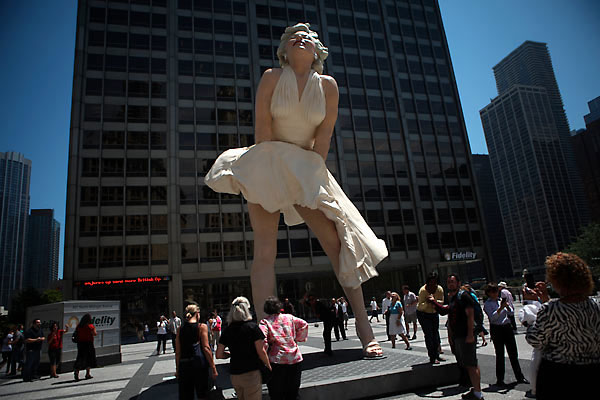
There aren’t a lot of fans of the enormous Marilyn Monroe sculpture next to Tribune Tower.
So what that men were standing dwarfed between the giant legs of the fake Marilyn, shooting photos of her crotch while one stuck out his tongue to mime a lick? So what if there were guys leering at her underpants and her exposed backside? Hey. Whatever makes people happy.
It’s creepy schlock from a fifth-rate sculptor that blights a first-rate public art collection.
Forever Marilyn, by dint of its size, shows us everything and somehow says almost nothing. And as a bonus, the sculpture even manages to unsexy the scene and the actress.
She is a a giant, silent avatar of non-consent, posed forever to be a sexual object for the pleasure of passers-by.
Only Lynn Becker found something moderately interesting about it:
To me, what’s most interesting is how the supersized human figure of Marilyn Monroe, a constant curving presence seemingly without a single right angle, plays out against the relentlessly rectilinear Miesian skyscrapers that compose her backdrop.
Then again, a gum wrapper is more sensual than Miesian skyscrapers.
Since it’s impossible for me to avoid—as are the throngs taking pictures of it—I figure I have to live with it as much as anyone else in Chicago, save for the friend of one commenter who "works in the lobby of the building behind Marilyn (the Equitable Building). She spends seven hours a day, now, looking at Marilyn’s underwear and watching people take ‘upskirt’ shots of her."
And I don’t find it creepy so much as kitschy: like an object from the Planet Hollywood going-out-of-business sale or the Lillian Vernon Catalog for the Very, Very Wealthy.
Which the artist, J. Seward Johnson, Jr. is: an heir to the vast Johnson & Johnson fortune.
Johnson is an odd duck: a spectacularly rich former washout who found a calling doing sculpture, and who has devoted a vast chunk of his fortune to perfecting the process of imitating real life in sculptural form:
The 50,000-square-foot Johnson Atelier here is considered the finest place in America to cast bronze. The nonprofit atelier employs 100 people, some of them apprentices in training. Its foundry employs the ancient, complex lost wax process of casting, which picks up the finest details of the work. The center also contains painting and drying rooms, and even a computer-guided laser that can create three-dimensional works from two-dimensional drawings. George Segal and Marisol are among sculptors who have cast works at the Atelier.
[snip]
Johnson’s process is so fine that it can catch the pattern of a herringbone jacket and the cracks from an old briefcase. After casting, Mr. Johnson’s assistants color the figures with a polychrome patina of paints developed by chemists just for the atelier. It is no wonder that it costs $46,000 to complete an original figure.
In that sense, there’s something almost poignant about Johnson’s artistic career—a scion of American industry pouring his immense resources into the complex, expensive process of producing simulacra of "ordinary people doing ordinary things"—captured in a statement on his web page:
My art is an imitation of life. [The sculptures] do many things; they can warm up . . . a park or public space and they invite people to come into that space, so that they don’t feel quite alone. They also make good neighbors—they don’t make a lot of noise.
Marilyn Monroe in The Seven-Year Itch was hardly an ordinary person doing an ordinary thing, but it feels like an extension of his life-size, painstakingly realist regular people, this time about their touchstones rather than themselves—with Monroe done not in physical scale, but in social scale.
Photograph: Chicago Tribune


